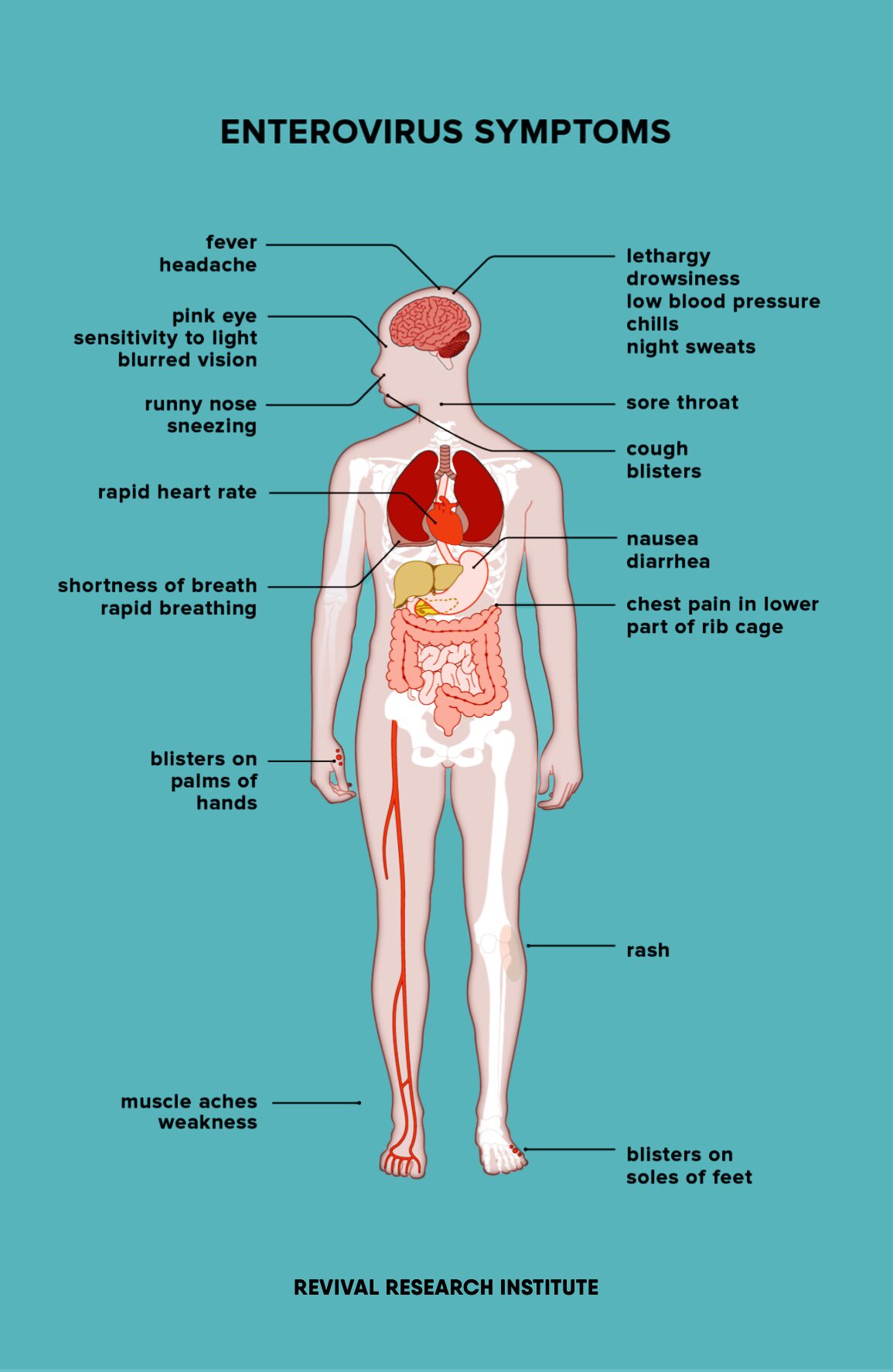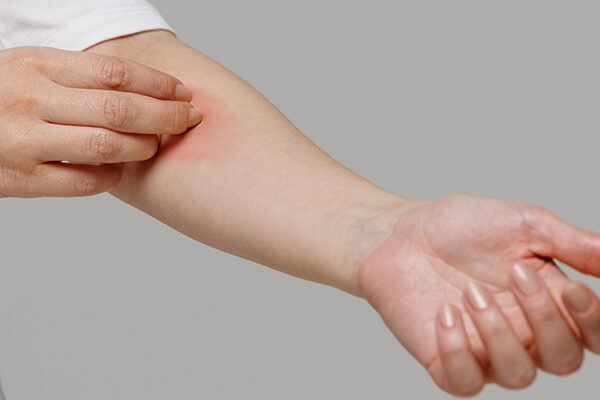Updated on February 19, 2024

Key Facts About Enteroviruses in Children
- Enteroviruses are extremely common. The viruses mostly cause diseases in infants, children, and adolescents. Most people have already been exposed to numerous enteroviruses and have developed immunity.
- Enteroviruses frequently don’t cause symptoms, or they cause just mild symptoms.
- Enteroviruses can spread when an infected person sneezes or coughs, releasing droplets into the air or onto surfaces. A child may inhale droplets or come into contact with a contaminated surface, affecting their eyes, mouth, or nose.
- The viruses are treated with supportive care, which includes fever or pain medication, rest, and hydration.
- In rare situations, viruses can cause inflammation in the brain, heart, or other regions of the body.
Introduction
Enteroviruses, a group of viruses that cause a variety of infections, usually only lead to minor symptoms, such as a common cold. However, in some cases — particularly in young infants or those with weakened immune systems, significant consequences can develop including cold-like symptoms (sore throat, fever, and congestion). The most well-known of the enteroviruses is Poliovirus (PV), other enteroviruses include the Coxsackie A and B viruses (CVA and CVB) and the echoviruses (ECHO: Enteric Cytopathic Human Orphan).
Read more about Human Rhinovirus/Enterovius.
They may also cause a rash, which is the characteristic indication of an enterovirus known as hand, foot, and mouth disease, or coxsackievirus. Understanding the complexities of this condition is essential for parents, caregivers, and healthcare professionals in providing prompt and appropriate care to affected children.
Also Read: Clinical Trials Diversity: Ethnicity in Clinical Trials
What are Enteroviruses?
Enteroviruses are a group of viruses that typically live in the human gastrointestinal tract. These viruses can cause various symptoms, ranging from minor respiratory or gastrointestinal issues to more serious problems like meningitis or myocarditis. Enteroviruses are more common in youngsters, with outbreaks occurring more commonly throughout the summer and fall.
It is estimated that over one billion individuals worldwide are affected each year. In the United States, enteroviral infections cause 30,000 to 50,000 hospitalizations each year. Some enteroviruses can cause mild problems like hand, foot, and mouth disease. A child with hand, foot, and mouth disease may feel sick for a week or more. They may also develop tiny blisters on their hands, feet, and occasionally in their mouth.
Also read: Eczema Coxsackium: Causes, Symptoms and Treatment
There are several forms of enterovirus infections that can cause severe diseases:
- Polio is caused by an enterovirus however, polio has been eradicated, but vaccination is still required to prevent the spread of cases brought on by travelers.
- Enterovirus-71 (EV-71) can cause serious infections in newborns and young children, such as meningitis and encephalitis.
- Human Parechovirus (HPeV) can increase body temperatures and cause skin rashes.
- Enterovirus D68 (EV-D68) is rare, however, it can cause difficulties like coughing, wheezing, and paralysis.
What are the Signs and Symptoms of an Enterovirus Infection in Children?
The signs and symptoms of a mild enterovirus infection include:
- Fever, rash, loss of appetite, and fatigue.
- Sore throat, ulcers in the mouth, or blisters on hands and feet.
Symptoms of more severe infections include:
- Vomiting
- Coughing
- Stiff neck
- Rapid heart rate
- Difficulty breathing
A serious infection can cause neurological symptoms, such as:
- Weakness or paralysis
- Seizures
- Unsteadiness and excessive irritability in infants and young children
If anyone suspects that their child has an enterovirus, it is advised they take their child to the doctor immediately.

A Distinctive Symptom – Enterovirus Rash in Children
One prominent and recognized symptom of enterovirus infections is the development of an enterovirus rash in children. The rash caused by enteroviruses is typically characterized by red spots or lesions that occur on various regions of the body. Understanding the distinct features of the rash is crucial for early detection and diagnosis.
Read more about enterovirus, here!
How is Enterovirus Infection in Children Transmitted?
Understanding how enterovirus infections are transmitted is of the utmost importance for prevention. Enteroviruses are highly contagious and can be transmitted through:
- Person-to-person contact: Direct contact with an infected person or their respiratory secretions.
- Fecal-oral transmission: Occurs when a person intake contaminated food or water.
- Contact with contaminated surfaces: Touching surfaces or objects that carry the virus on them and then touching the face.
Prevention of Enterovirus Infection in Children
Regardless of the precautions taken, children usually do become sick with an enterovirus infection at some point. However, emphasizing hygiene can help in minimizing the spread of infection.
Here are some ways to reduce this risk of children becoming infected.
- Make sure to wash your children’s hands thoroughly and frequently, especially before eating, after using the toilet, changing diapers, or wiping noses.
- Clean surfaces that may have been in contact with germs—such as diaper changing tables—with soap and water.
- Clean potentially contaminated toys, and clothing, and avoid sharing glasses, silverware, towels, and toothbrushes.
- Encourage your child to cover their nose and mouth with a tissue, or their arm if a tissue is not available when they cough or sneeze.
- If the child becomes infected, keep them away from childcare or school to avoid spreading the infection to others.
Read more about how to prevent rhino enterovirus.
Diagnosis of Enterovirus Rash in Children
Enterovirus infections, including rash, are frequently diagnosed using a combination of clinical evaluation, medical history, and laboratory tests. Healthcare professionals may perform throat swabs, stool samples, or blood tests to confirm the presence of enteroviruses.
How can we Treat Enterovirus Infection in Children?
There is no particular antiviral treatment for enterovirus infection, but supportive care can help manage symptoms and facilitate recovery. Treatment can include:
- Fever Reducers: Over-the-counter drugs that relieve fever and discomfort.
- Hydration: Ensuring appropriate fluid intake to avoid dehydration, especially if gastrointestinal symptoms are present.
- Rest: Providing the child with plenty of rest to aid in the recovery.
Takeaway
Enterovirus rash in children is a common manifestation of enterovirus infections, and parents, caregivers, and healthcare professionals must grasp its symptoms, causes, and treatment choices. Early detection, appropriate treatment, and preventive measures can positively impact the health of affected children and the community. Many clinical research organizations have also been working to find better treatment options to manage this condition effectively.






